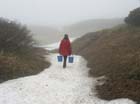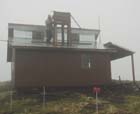
Maureen carrying the water buckets from the lake to the cabin in the rain
and fog.

Charlie fixing the chimney so
that it does not down draft in a certain wind. Finally after six years,
I figured out what the problem is and fixed it.
 Maureen on one of our hikes in one of the lulls between
storm furies. These are the remnants of huge drifts left by winter storms.
Some are still 30 feet deep and
Maureen on one of our hikes in one of the lulls between
storm furies. These are the remnants of huge drifts left by winter storms.
Some are still 30 feet deep and
will be around until August.
(Click on any Image to see a higher resolution version)
When we first came to Kambalnoye in 1996 to build our cabin and get
started with this "study that never ends", we had no idea what
we were getting into. There were supposed to be a lot of bears and people
referred to the area as the forgotten place. We soon found out that the
reason people never came here was because of the weather and it almost
was tough enough on us the first year that we never came back. We eventually
realized that the numbers of bears and our prospects of working with orphans
would give us all the opportunities we ever dreamed of, so we persevered.
The good thing about the weather is that it helps keep our study animals
and us isolated. As things kept getting more interesting each year we
learned to ignore the elements.
Since we got here this year, more than two weeks ago, the weather has
been very difficult to ignore. The temperature averages about 4 degrees
C, there has been days on end of thick fog, the wind blows and it pours,
as it is doing this minute. When the clouds do lift a bit, there is fresh
snow only a few hundred feet above us. We put on layers of warm gear and
get out when we can to keep track of whether Biscuit is about to be bred.
So far she has not been, but she does seem to be showing some faint signs
of interest towards male bears.
Brandy's new cubs are shy of us and it is interesting to see how she is
slowly teaching them not to be afraid, but at the same time promotes fear
of the other bears by chasing away every one that does not have cubs themselves.
Bears who have young cubs seem to respect others with the same vulnerable
aged offspring and don't hassle each other, but they do not hob-nob much
either.
I subscribe by e-mail to a couple of newsletters that keep me informed
about what is going on in the human side of the bear world. They are managed
by people in Canada and the US who take the time to communicate there
concerns about various issues and ask each other for information. For
instance one guy asked the other subscribers what was considered to be
a viable population of grizzlies. This means, I guess, the minimum number
of bears in a isolated population that it would take to sustain that population
given all the hazards in a bears life. I didn't see any responses, but
I thought about the question and wondered if the person who asked it did
so because he realized that the answer was still being played out. It
is estimated that there were once well over 50,000 grizzly in the lower
48 states of the US before European settlement. Now there are only about
1,100 and it is a big struggle to keep that number from shrinking even
further. What does that say about how many bears you need for a viable
population? It seems to me that as long as people are as unreasonably
afraid of these animals as they are, their numbers will decrease. The
sad thing is that so much effort keeps being directed towards keeping
people afraid of them. At the same time, there is much done to make bears
fearful of people and occasionally bears resent the techniques applied
to them toward this purpose. So the cycle of fear does another round and
grizzly numbers keep decreasing.
Recently, we subscribed to one newsletter and saw from a piece in the
New York Times, that Interior Secretary Gale Norton has decided to abandon
the highly controversial plan to reintroduce grizzlies back into the Bitterroot
ecosystem of Idaho and Montana. She is responding to Governor Dirk Kempthorne
of Idaho who has launched a lawsuit against what he sees as bringing "massive,
flesh-eating carnivores" to his state.
These misunderstandings fortify my already strong conviction that there
is a urgent need to show people that these animals are enormously different
than they are led to believe, once they are treated oppositely than they
historically have been. That is why Maureen and I struggle on with our
work here, through wind, fog and rain. While cabin-bound, we are continually
thinking of how to make our demonstration more meaningful to those who
would use our findings and apply them to a different approach to bear
management elsewhere. We know that grizzlies are far from what is implied
by the statement that they are "massive, flesh-eating carnivores".
If only others could experience what we do each time we spend time with
these bears that only know humans as friends. We will persevere through
this horrible stretch of weather and continue to show
people like the Governor what they really are like.
-Charlie